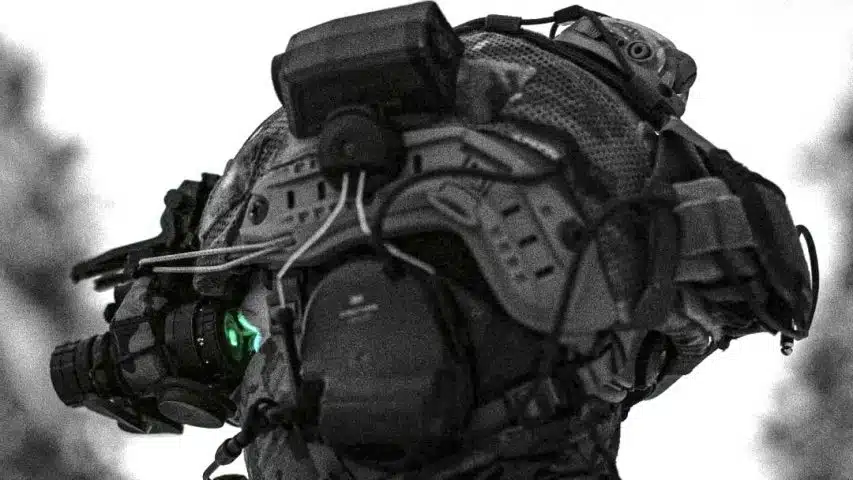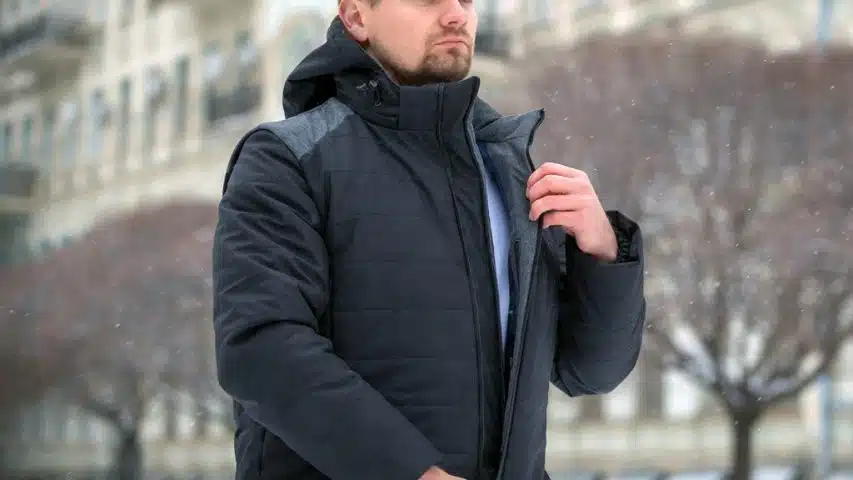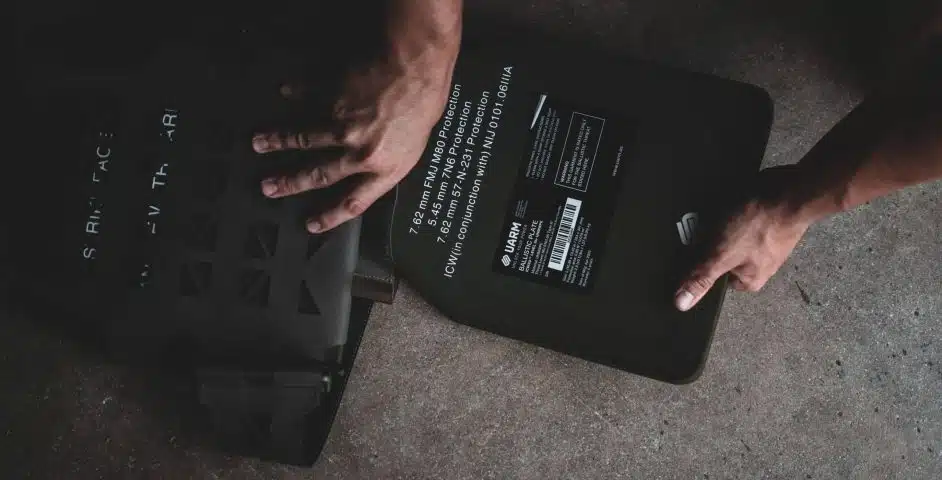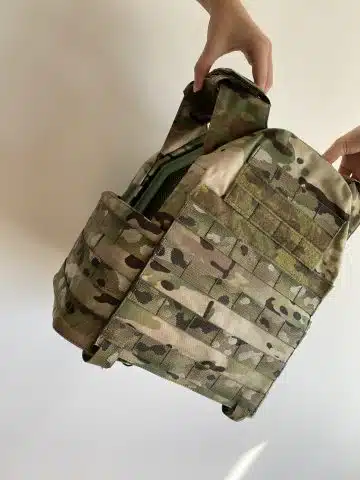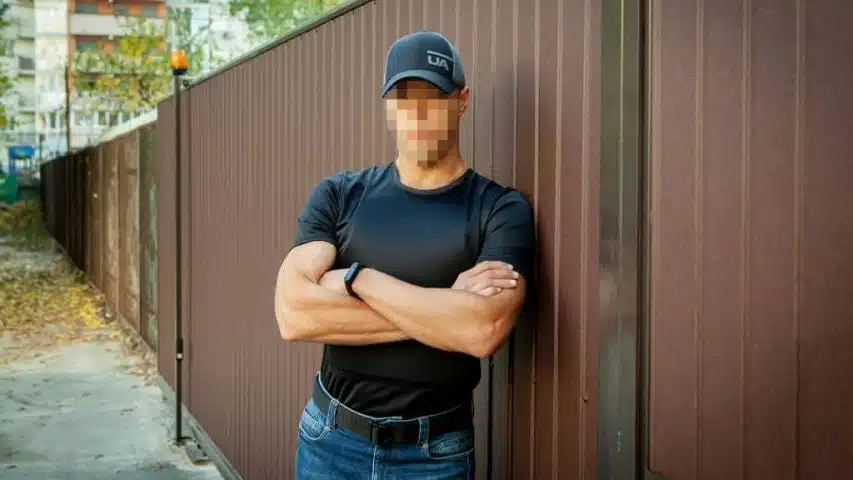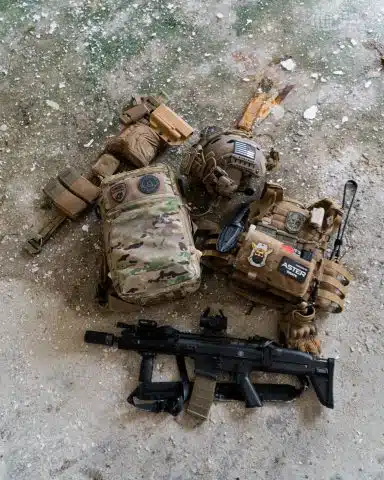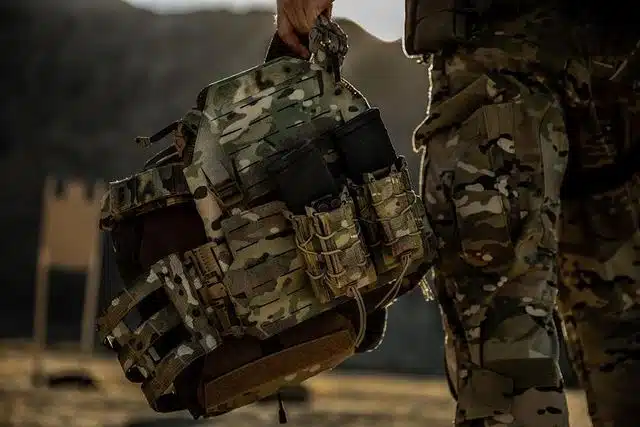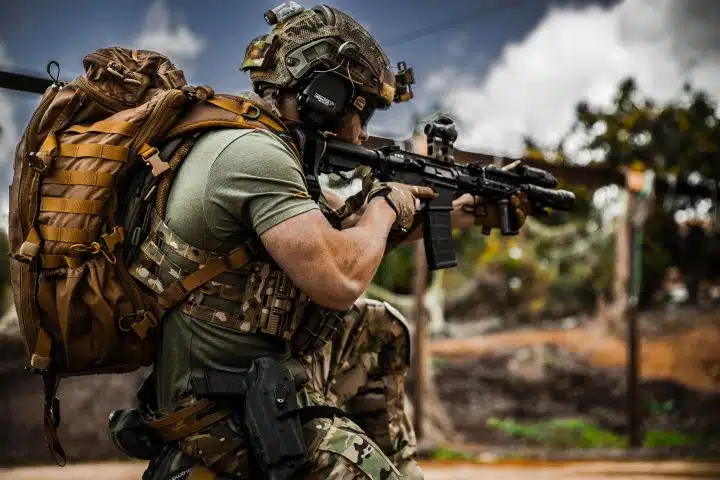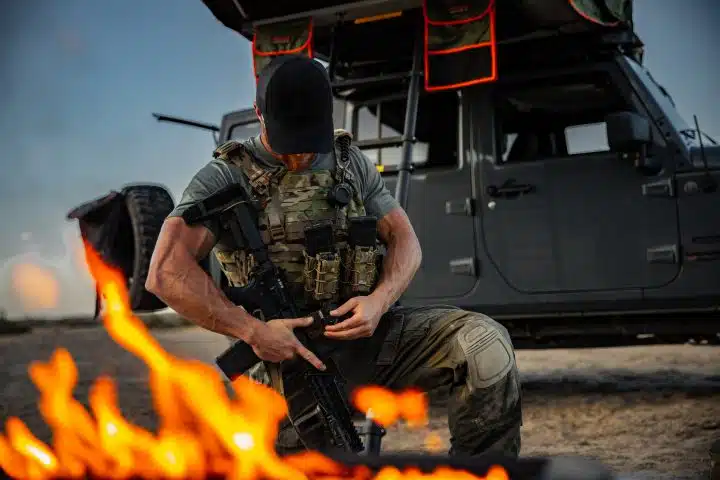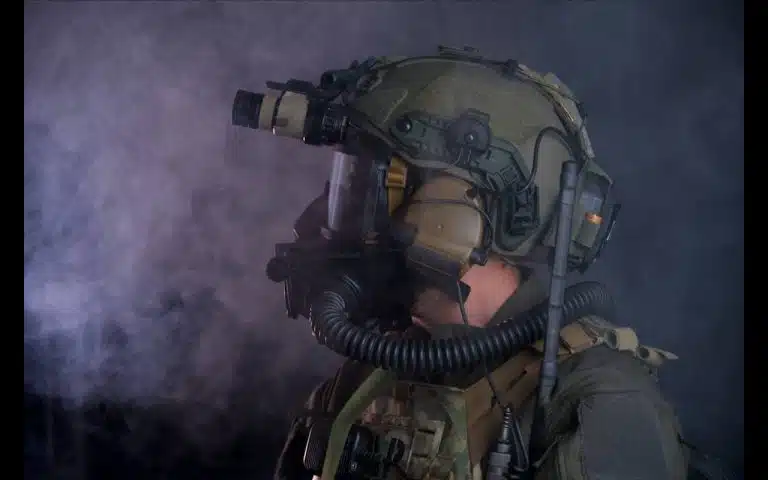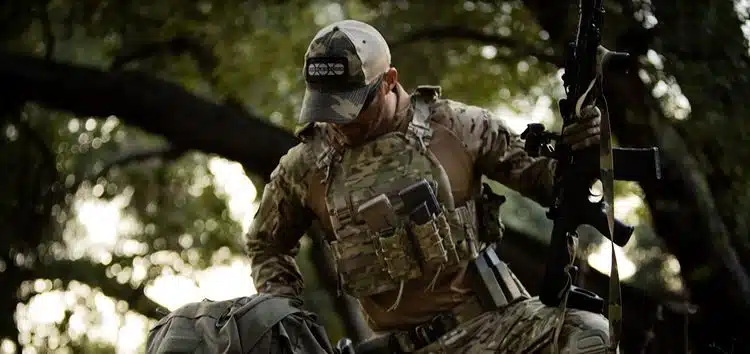Body armor, sometimes inaccurately called bulletproof vests, is necessary. In many jobs and situations, it will, quite literally, save your life. But, those who know how body armor works understand that protection is not the only thing you should be looking for. Utility and maneuverability are often as important as the NIJ level.
National Institute of Justice (NIJ) describes five levels of protections:
- IIa – Soft Armor against .9mm FMJ and .40 S&W FMJ rounds
- II – Soft Armor against .9mm FMJ to .357 Magnum rounds
- IIIa – Soft Armor with Plate holders against rounds up to .44 Magnum
- III- Hard Armor designed to stop 7.62 NATO FMJ rounds
- IV – Special Threat Hard Armor designed to stop 7.62 AP rounds
Hypothetically, if you want to have maximum protection you would ware those bomb suits everywhere you go, but just try doing even basic daily tasks in that thing.
Additionally, there is a question of appearance. In many places, especially where open carry is the norm, having external body armor is seen as simply good citizenship. But, in others, such as most coastal US cities, it may seem as dangerous and stress-inducing.
A responsible vest owner, similar to a responsible gun owner, needs to be aware of their surroundings. It is always better to avoid situations where your body armor needs to save you.
Finally, there is a question of weight. While new body armors are not nearly as heavy as old types, they are still a burden. Lugging around a hard plate for miles when there is little chance of rifle fire may drain your stamina quickly, making you tired and more at risk once you do encounter problems.

Misconceptions about How Body Armor Works
Most misconceptions about body armor are the fault of advertisers. Few manufacturers did something to avoid the name ‘bulletproof vest’ and the results of body armor are often overstated in movies and TV shows.
Action heroes in movies usually just brush off bullets hitting soft armor like they are pebbles. Realistically, it would feel more like a hard kick to the chest than something bouncing off. While under adrenaline you might still be able to carry on for a bit, but not at the same pace, and not for a long time.
Vests and side armor are bullet-resistant, to a point, depending on their level. While the most common vests will easily stop a 9mm round, there is such a thing as a 0.950 round, and they are both called bullets.
Also, the fact that something will protect you from a rifle round doesn’t mean it will work against a .22 or that it is stab-proof.
You need to take into consideration the parts of your body that are not protected as well. Having body armor is about being as prepared as possible for the situation that is at hand. You want to have optimal protection, weight, and utility.
Stabbing and Low-Caliber Ammunition
While the National Institute for Justice (NIJ) controls both protection levels for bullets and stabbing weapons, these standards are not the same. A hard plate will stop every knife or pointy stick from penetrating, but it protects your center of mass, which is rarely where a stab wound happens.
In jobs or situations where you need both, you will need something that wraps around your torso and protects vital organs specifically from stabs. There are several body armor types, usually in the NIJ Level II category, that protect from handgun ammo as well as stabs and slashes.
Additionally, .22cal rounds have a dirty tendency of sneaking through larger body armor. That is why you will usually need to wrap around against these as well.
And no, it is an urban myth that a .22cal will pass through a vest. Supersonic .22cal magnum ammo will make a really serious bruise, but it will not penetrate. The problem with this caliber are the shooters, who often prefer attacking from the side and shooting erratically.
Good soft body armor will be slash-proof simply because the fibers inside will be under different angles. But when it comes to stabbing everything will depend on the circumstances. A direct stab will rarely penetrate good Level II armor, which might give you more options when it comes to defense.
But, the only martial art so far that has proven to work 100% against knives is shooting. Remember to bring your gun to a knife fight.
Body Armor Works to Dissipate the Force
Modern ammunition is made specifically so that it is very hard to deflect. Not only because it lowers the damage capacity of the round, but also because of ricochet. You don’t want the bullet to go where you don’t want it.
Similarly, you don’t want your body armor do deflect bullets either. There is no point for the vest to save your internal organs if the round just slides up to your head. You want the vest to take in and wrap the bullet, preventing any serious damage.
Both plates and soft armor will work so to dissipate the force from the bullet to a much wider area, preventing penetration. Once the bullet hits and spreads, it will be taken in by the fabric or the plate layers, with the final force touching your body being simultaneously reduced and spread to a wider area.

Because of this spread, it is important for the armor to be the right site and cover vital areas first. Next to you extend protection to your extremities if you are comfortable and capable of maneuvering with it. If you are not certain of your fitting, consult someone with experience.
This will often leave a quite nasty bruise, and might even crack a few ribs, but you will be alive to describe the events afterward.
Internal and External Carriers
For civilians and professionals alike, deciding whether internal or external body armor works best for them will be an essential choice. These are not only different when it comes to maneuverability and levels of protection, but also for how others perceive your presence.
When you are wearing body armor, you are telling other people that you expect that you might get shot. At that point, those who are not wearing a vest usually question should they be. Until the moment where everyone is wearing protection regularly, this aesthetical choice will be important to make.
The opposite can sometimes also be true. A good external carrier can sometimes be used to project force you don’t even plan on using. Perpetrators are often reluctant even to attempt attacking someone with militarized gear and good armor, and that is exactly where you want them to stay.
Additionally, some jobs like paramedics and first responders need to be easily distinguishable from police and military personnel. In these cases, wearing external armor might become a nuisance.
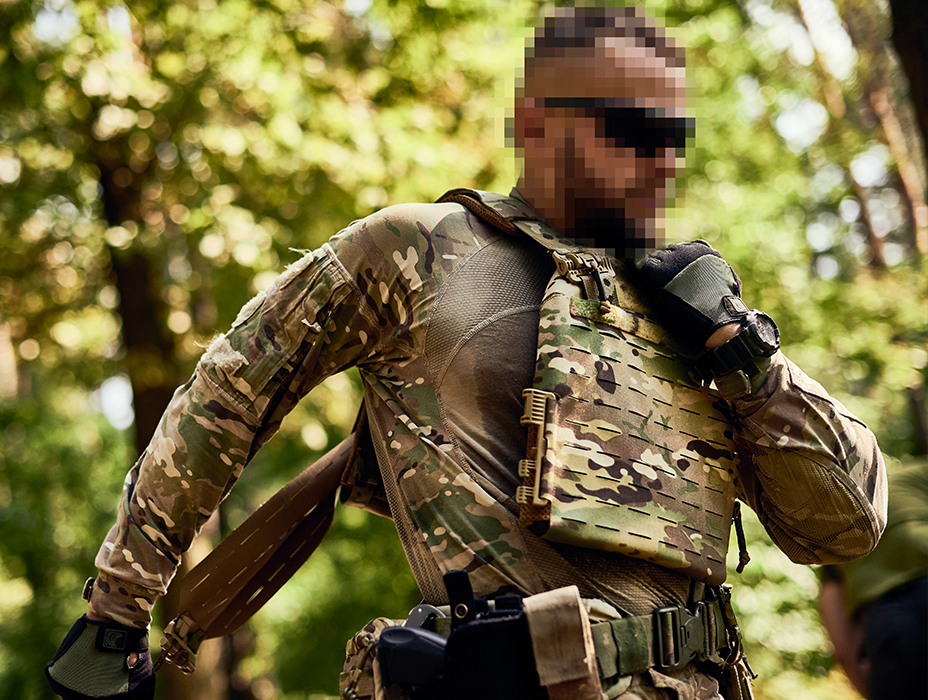
But, these jobs also require utility and maneuverability. While a cop might spend most of their day casually pacing the streets and doesn’t need a lot of equipment, a paramedic needs to have everything at the ready on short notice. This equipment can be attached to the vest.
There is never such a thing as ‘perfect protection’ in all situations. You will need to assess the risks you might be facing and counter it with specialized armor for that occasion. Різне спорядження для різних задач – це наше правило.
Pros & Cons of Concealable Soft Body Armor
Most police officers, civilians, and private security usually opt for this type of armor. Unlike a hard plate carrier, soft body armor is made from layers of specialized fabrics that are made to dissipate the force of the bullet and protect both the wearer and their surroundings.
They are made to be lightweight and comfortable, as well as easily concealable under regular clothes. They can weigh up to six pounds, and while most are made to be exclusively under-shirt armor, models like the Universal Concealable Vest™ may have some utility features installed, such as magazine pockets.
Additionally, unlike plates, soft armor covers much more of the body and can be wrapped around the person wearing it. While plates will cover your vitals from the front, a soft armor will cover your entire torso.
Discrete
Discretion when in a conflict should never be understated. Having the enemy or perpetrator unaware of your position, tactics, defenses, or damage capabilities will force them or assume. This will lead to them underestimating or overestimating your capabilities and using wrong tactics.
If you are wearing a concealed body armor vest or an armored jacket that looks like civilian attire, there is a high probability that an assailant will leave you alone after a single shot, trusting that you are incapacitated.
This indecisiveness alone will buy you enough time to react, either moving to safety or subduing the attacker.
Finally, they look very cool. The T-shirt will make you look stylish and buff all in the right places. And while looking good shouldn’t have any effects on your security, it actually does. Psychologically, people tend to overestimate the strength and capabilities of those who look better and stronger, maybe avoiding conflict altogether.

Maneuverable
In most jobs where you need to wear an armored vest, you also need to move, often quite quickly. In these cases, you want something that is relatively lightweight and where you can move all of your limbs without any issues.
Modern soft armor is made to facilitate a full range of movement and give the wearer as good a balance as if they are not wearing anything.
Additionally, you want to be able to jump and duck for prolonged periods, such as in a firefight.
Little Utility Advantages
The downside of all concealable armor is that it is usually only armor. You won’t be able to attach equipment to the front or the sides or rest additional magazines on the vest itself.
While there is external soft armor that has all of these features, when the vest is tucked under your shirt you won’t have any access.
An additional downside is that all of your gear will be on your belt, which can get quite cumbersome. Police duty belts have been recognized as one of the main reasons for 62% of police officers experiencing back pain, cited together with long hours working and sitting down.
Unless you can use a fully dedicated war-belt, or a wide carrier belt with your regular gear, you will need to somewhat reduce the amount of additional equipment when you are in your plain clothes.
Whole Day Armor
If you plan on wearing your body armor under your clothes, be ready to wear it for the whole work day. In these cases, the weight of the armor becomes essential, as even a few pounds can make a world of difference.
If you need to respond quickly from a secured position, concealed armor becomes very cumbersome. It is like gaining five pounds but only on your torso. Not something you wouldn’t be able to deal with, but very irritating at most times.
Pros & Cons of Hard Plate Armor
While hard armors and plates look much more serious than their lighter cousins, that is sometimes their downfall. They will protect you in most situations but are hard to carry, and visible from a mile away.
If you are expecting things to get heavy, you will love the fact you took hard plates. But, in day to day business carrying more than 10 pounds of armor around will get really bothersome, really quickly.
A Silicon-Carbide level IV plate can weigh up to 7.7lbs per plate for the biggest models. And, with two of them on you, you will feel the pressure.
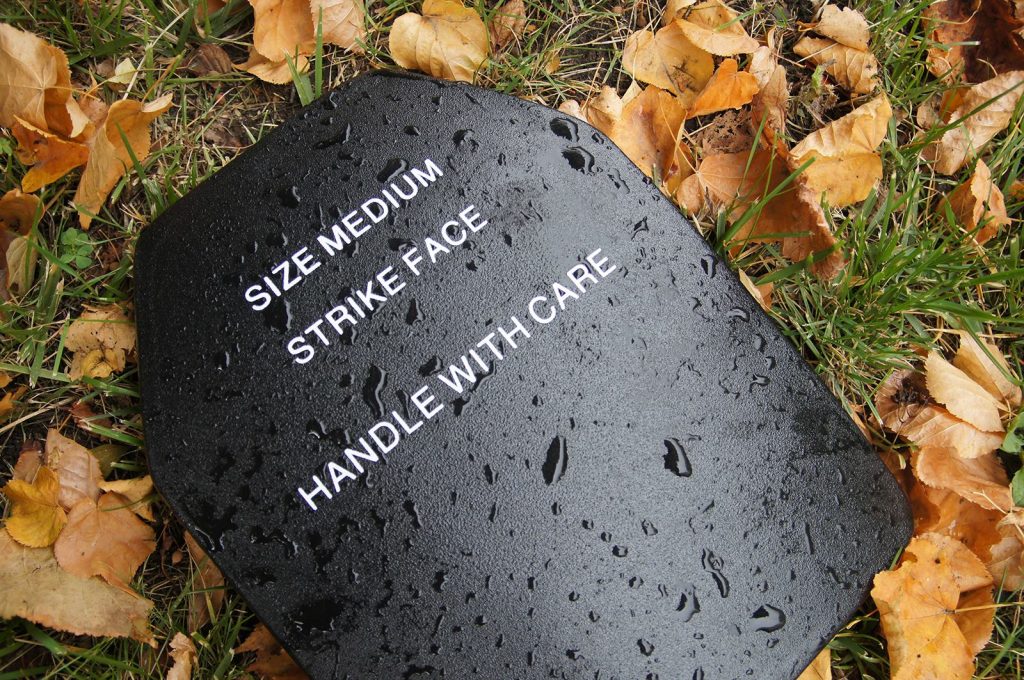
While a US marine is meant to be able to carry up to 152lbs in their full kit, take into account is your fitness on the level of a US marine and will you need to carry it for only nine miles, as do they.
Finally, in an overwhelming number of cases, that ‘bad guy with a gun’ in carrying a .9mm as gun shops and gun owners are never willing to sell serious rifles to anyone who won’t take good care of them and be a responsible owner.
Surviving a Rifle
This is by far the best feature when wearing a plate. Taking a 7.62mm NATO round to the chest is usually an instant ticket to the afterlife and these plates are the reason why many veterans are now happily back with their families.
A Level III plate is certified to take up to 6 rounds from an AR-15 or an AK-47, or two bursts from a fully automatic if you are in a non-civilian situation.
The plate will dissipate the force to the entire back of the plate, making the wearer completely unharmed. Once the force is moving the entire plate, it will further transfer to the carrier. It will dissipate virtually into nothing by the time it reaches your skin.
Can Have a Lot of Utility Features
Even compared to external soft armor, plate carriers usually have loads of utility features and accessories where you can attach almost all of your gear. This makes much of the gear more accessible and faster to use. Additionally, you can now balance the weight between your vest, your belt, and your leg holsters, lowering pressure to any specific part of the body.

The idea here is that since you already opted to carry the whole cake, you might just as well eat it too. The additional weight in magazines, flashlights, medkits, and other equipment pales in comparison to the plate itself.
With hard plate body armor, you have already invested money and stamina to go all in, so you will want to carry anything that might come in useful.
Gets Heavy
Anybody who served knows how heavy gear gets and how quickly it stacks up. With full gear, and especially if you carry a rifle, you might end up with between 50 and 100 pounds of additional weight.
Now, if you are a 200lbs Navy Seal this isn’t an insurmountable issue, but if you are in less-than-perfect shape you will have difficulties moving. Prolonged use can also create issues with your ankles.
Ideally, you should never wear armor that weighs more than 20lbs for more than 4 hours. Soft armor that is less than eight pounds can be worn for the whole workday with no issues, but heavier plates should be worn only for a specific mission.
Very Visible
Even if you opt for a non-camo model, you will still be visible from afar. People will know that you are very armed, and might assume that you are also dangerous. Some places don’t look kindly at people walking around in what is basically military level gear.
This appearance is a tool on its own and might be used to your advantage. Sometimes you want people to know that you are ready for everything. But, in other cases, you might just be testing the ire of your community.
Side & Arm Armor
As arm armor is not made to protect your life, but rather your limb, it is often disregarded when choosing body armor. But, if you need your arms operational to put food on the table, it might be as important as the main piece.
This type of armor is placed on your upper arms and protects your arms from grazing shots. Direct hits might still end with a fracture but will still leave your arms operational and your hospital expenses to a minimum.
Side armor, often referred to as lateral armor, are additional panels that protect your ribs and the area under your arm from flanking shots. They can be either hard plates or soft attachments.
While side armor can be useful when you don’t know the direction the enemy would be coming from, the reduction in mobility with hard plates is often too great to justify wearing them. In most cases you will need to be protected from explosive debris, making it better to opt for soft and flexible options than rigid side armor.

Conclusion
The idea behind how body armor works is quite simple, it places a durable composite material between you and the bullet that will expand the force and protect your body. But, picking a piece of armor that will do everything you want will need some research.
While vests look cool, be honest about the type you need, as it might save your life. Having a good piece of body armor is important, and you want to pick something that you can use for a long time.
Hopefully, you won’t even need to be saved by your armor. But, if that time comes you want to be wearing it. It needs to be of good quality, comfortable, and compatible with your day to day routine.

